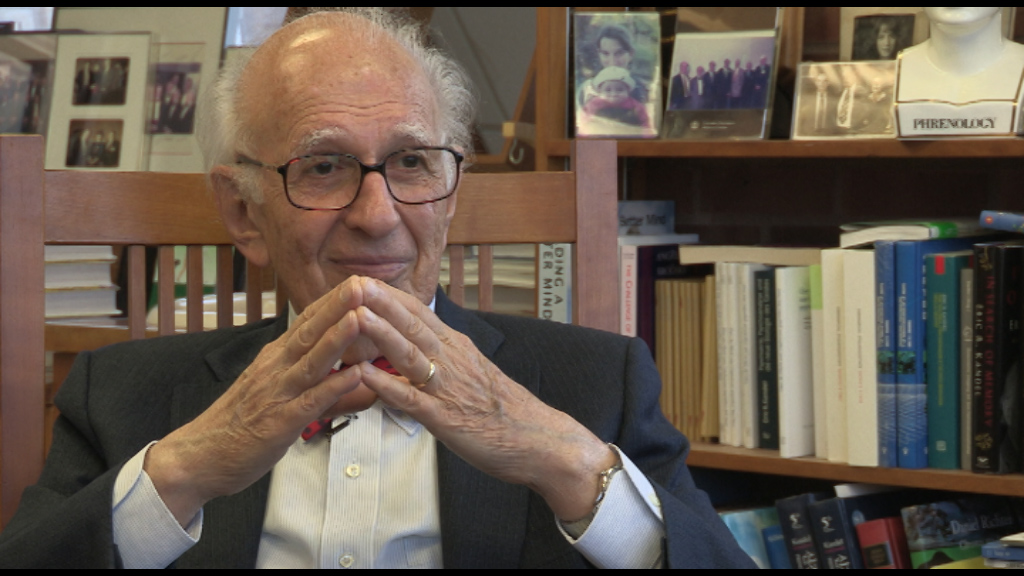NEXT STORY

Understanding how LTP functions in relation to memory storage
RELATED STORIES

NEXT STORY

Understanding how LTP functions in relation to memory storage
RELATED STORIES



And just as I was beginning to think in this direction, Seth Grant and Mark Mayford came in the lab. In fact, I may be being unfair, maybe some of my thinking evolved because they were in the lab and talking about this. And so we decided to go ahead and try to dissect out signalling pathways and see whether we can dissect LTP and memory storage and relate them to one another.
Now Seth Grant was very much interested in the tyrosine kinase pathway, a very important second messenger pathway that we had never [explored] in Aplysia. And he had a quite good inhibitor for tyrosine kinase, and when we used that, we blocked LTP. Now there are a number of tyrosine kinases, and he was able to get genetic knockouts for the four major tyrosine kinases. And we explored all of these, and LTP and memory storage, and none of them had any effect except for one: the knockout of the fyn tyrosine kinase. That was quite beautiful. Eliminated LTP, and eliminated memory storage. That was wonderful, knocking out a single gene, selective interference, with, you know, tyrosine kinase pathway, and at the same time with this one molecular knockout to get rid of memory storage in the hippocampus.
And Richard Axel was chairman of a symposium at Cold Spring Harbor, and he invited me to present this, and he also invited Susumu Tonegawa who'd made a parallel observation. Susumu did an analogous experiment. He knocked out CaM kinase II with the gene knockout. Found it interfered with LTP, and also found that it interfered with memory storage. So here we had a breakthrough, it was really quite inspiring.
And that got me really interested in trying to dissect things a little bit more finely. And I thought I would begin by exploring LTP. And one of the things that I'd found very powerful in Aplysia was the fact that synaptic facilitation had an early phase, which did not require protein synthesis, and a late phase that did, and so we began to explore LTP, and we found a similar thing. There's an early phase, produced by a single train that was protein synthesis-independent, a late phase that was protein synthesis-dependent. The early phase did not require cyclic AMP—it was very different than in Aplysia. It required CaM kinase, calcium influx, etcetera. But the late phase required the cyclic AMP-dependent protein kinase, and it required not serotonin as a modulator, but dopamine acting through D1, D5 receptors. So that got us quite inspired to seeing whether we could really home in a little bit better on LTP.
Eric Kandel (b. 1929) is an American neuropsychiatrist. He was a recipient of the 2000 Nobel Prize in Physiology or Medicine for his research on the physiological basis of memory storage in neurons. He shared the prize with Arvid Carlsson and Paul Greengard. Kandel, who had studied psychoanalysis, wanted to understand how memory works. His mentor, Harry Grundfest, said, 'If you want to understand the brain you're going to have to take a reductionist approach, one cell at a time.' Kandel then studied the neural system of the sea slug Aplysia californica, which has large nerve cells amenable to experimental manipulation and is a member of the simplest group of animals known to be capable of learning. Kandel is a professor of biochemistry and biophysics at the College of Physicians and Surgeons at Columbia University. He is also Senior Investigator in the Howard Hughes Medical Institute. He was the founding director of the Center for Neurobiology and Behavior, which is now the Department of Neuroscience at Columbia University. Kandel's popularized account chronicling his life and research, 'In Search of Memory: The Emergence of a New Science of Mind', was awarded the 2006 Los Angeles Times Book Award for Science and Technology.
Title: Dissecting LTP and memory storage
Listeners: Christopher Sykes
Christopher Sykes is an independent documentary producer who has made a number of films about science and scientists for BBC TV, Channel Four, and PBS.
Tags: Susumu Tonegawa
Duration: 3 minutes, 16 seconds
Date story recorded: June 2015
Date story went live: 04 May 2016